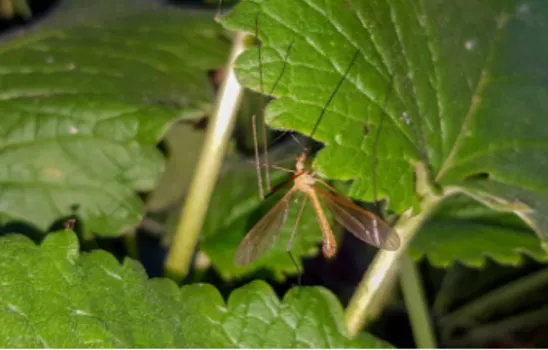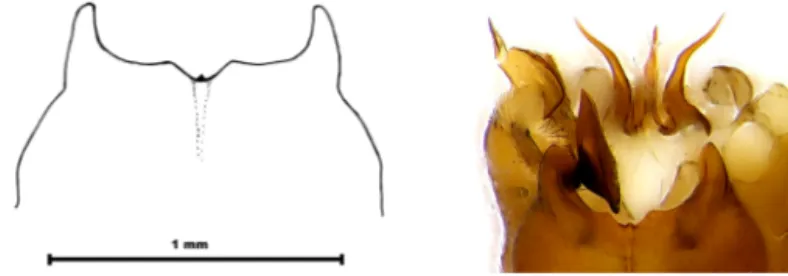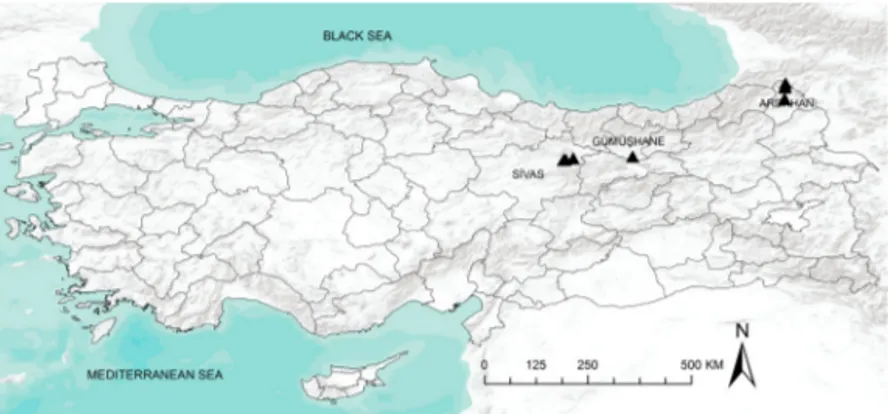A New Species of Tipula, Subgenus Lunatipula From Turkey
(Diptera, Tipulidae)
Üzeyir ÇAĞLAR1 Derya ÇİFTÇİ2 Şirin Bahar CAN3 Hasan KOÇ4 1Gazi University, Vocational High School of Health Services, Ankara, TURKEY
2,3Gazi University, Faculty of Science, Biology Department, Ankara, TURKEY 4Muğla Sıtkı Koçman University, Faculty of Science, Biology Department, Muğla, TURKEY
e-mails: 1ucaglar@gazi.edu.tr, 2dcanpolat@gmail.com, 3sirinbahhar@gmail.com, 4khasan@mu.edu.tr
ORCID IDs: 10000-0002-8401-0155, 20000-0002-7670-4392, 30000-0001-5787-5228, 40000 0002 2560 4527
ABSTRACT
The specimens in this study were obtained in the Environmental Impact Assessment study (EIA) in 2013 and post-construction monitoring study in 2019 within the scope of the Trans Anatolian Natural Gas Pipeline (TANAP) project. As a result of the studies Tipula (Lunatipula) tanap sp. n. Koç & Can is described and diagnostic characters are illustrated. The distributions of new species are mapped. It distinguished from related congeners by the difference of ovipositor and sternite 8 shape of the ventral process of the aedeagus.
Key words: Diptera, TANAP, Tipula, Lunatipula, Crane flies, Palearctic, Turkey.
Çağlar, Ü., Çİftçİ, D., Can, Ş.B., & Koç, H. (2020).A new species of Tipula, Subgenus Lunatipula from Turkey (Diptera, Tipulidae). Journal of the Entomological Research Society, 22(2), 219-225
ÇAĞLAR. Ü., ÇİFTÇİ, D., CAN, Ş.B., KOÇ, H.
INTRODUCTION
Tipulidae family are known as the crane flies. Adults are short-lived and found in moist and shady areas such as meadows, shrubs or forests where they feed on plant sap and nectar. Larval periods can be one year or longer. They generally live in semi-aquatic or terrestrial environments (Oosterbroek & Theowald, 1992).
Tipulidae, which includes mosquitoes of medium and large body size, is one of the well-known Diptera families in the world. In adults, rostrum often developed with nasus. Ocel eyes are absent. Antennae have 13 segments; some species may have more segments. The V-shaped mesonotal stur located in the dorsal of the thorax and the 2 anal veins on the wings are its outstanding features (Oosterbroek, 2006).
The family Tipulidae is represented in the world by 4321 taxa. There are more than 30% of these species (1360 species and subspecies) in the Palearctic region. Also, 521 taxa are recorded from Europe (Oosterbroek, 2020). The number of species known from Turkey has been increased significantly in recent years. So, the number of known Tipulidae taxa from Turkey are rise to 161 (Koç, Özgül & Hasbenli, 2015). MATERIAL AND METHODS
Specimens of new species were collected from provinces of Ardahan, Gümüşhane and Sivas during the studies on the Trans Anatolian Natural Gas Pipeline (TANAP, passing through 20 provinces and having 1805 km line) in 2013 and 2019.
The adults in the study area were collected usually by sweeping method with the help of 40 cm in diameter swep net. Genital preparations of some of the specimens brought to the laboratory for diagnosis were made. These genitals were then placed in small capsules filled with glycerin and attached to the needles of the specimens.
The genital structures were drawn under a stereoscopic microscope (Olympus SZX-7) with the aid of a drawing tube. Photographs of the habitus and some part of aedeagus were taken at different depths with a digital camera Olympus E330. All photographs were edited with Helicon Focus v. 3.1. The map was created in ArcGIS 10.1 program.
Terminology of morphological features follows that of McAlpine (1981) and H. De Jong (1997). The materials referred to in this study are stored at Muğla Sıtkı Koçman University, Faculty of Science, Department of Biology, Zoology Research Laboratory. RESULTS
Tipula (Lunatipula) tanap sp. n. Koç & Can (Figs. 1-12)
Material examined: Holotype: Turkey: Ardahan, Hanak, Baştoklu Village, 1996 m, 38T 314332 E/
4562989 N, 23.07.2013, leg. Koç, 1 ♂; Holotypus, Tipula (Lunatipula) tanap sp. n. det. Koç (Muğla Sıtkı Koçman University, Faculty of Science, Department of Biology, Zoology Research Laboratory) 1 ♂.
Paratypes: Ardahan, Hanak, Baştoklu Village, 1996 m, 38T 314332 E/ 4562989 N, 23.07.2013, leg.
Çağlar, 3 ♂♂, 1 ♀; Ardahan, Alaçam, 2026 m, 38T 314356.94 E/ 4563169.14 N 27.07.2019, leg. Can 5 ♂♂, 1 ♀; Ardahan, Posof, Çamyazı Village, 2453 m, 38T 314397 E/ 4590645 N, 24.07.2013, leg. Koç, 4 ♂♂; Ardahan, Yeniköy, 1975 m, 38T 315805 E/ 4592457 N, 24.07.2013, leg. Koç, 3 ♂♂, 2 ♀♀; Ardahan, Derinsu, 1419 m, 38T 316595 E/ 4601085 N, 24.07.2013, leg. Çağlar, 2 ♂♂; Ardahan, Yeniköy, 2088 m, 38T 315759 E/ 4591741 N, 24.07.2013, leg. Hasbenli, 1 ♂; Sivas, İmranlı, Beğendik Village, 1635 m, 37S 416407 E/ 4415399 N, 19.06.2013, leg. Çağlar, 4 ♂♂; Sivas, Kapumahmut, 1690 m, 37S 430415 E/ 4418174 N, 20.06.2013, leg. Koç, 4 ♂♂, 2 ♀♀; Sivas, Kapumahmut, 1675 m, 37S 430507 E/ 4418198 N, 20.06.2013, leg. Çiftçi, 4 ♂♂; Sivas, Imranli, Kılıçköy Village, 1672 m, 37S 412446.28 E/ 4414439.15 N, 29.06.2019, leg. Koç, 1 ♂; Gümüşhane, Kelkit, Belenli Village, 2100 m, 37S 540966 E/ 4422098 N, 17.07.2013, leg. Koç. 1♂.
Male description: Habitus as in Fig. 1. Body length: 9-11 mm, antennal length: 4,5-5 mm, wing length: 12-14 mm.
Rostrum well-developed, yellowish brown. The behind of the eyes, forehead and vertex greyish brown. Basal segments of the antennas yellowish brown, flagellar segments yellowish brown to brown, but in some specimens the 1st flagellar segment yellowish brown. Flagellar segments cylindrical with the base slightly thickened. Circlet setae on flagellar segments shorter than the segments. Palp segments brown, the last one blackish brown. Nasus small.
Thorax usually greyish brown. Catepisternum and anepisternum gray to brown, dorsal parts darker. Prescutum stripes uncertain. Coxae, trochanters and femora basally greyish brown. The other leg parts brown to brownish black towards the tip. Spurs distinct, spur formula 1.2.2. Wing membrane greyish white and anterior parts light yellowish. Veins are brown, pterostigma indistinct, light yellowish brown. Discal cells small as in Mediotipula species and its length approximately 1,5 times its width. Petiole of veins M1+2 longer than m-cu. Squama with several short bristle. A2 and Cu veins ends with curved, not straight.
Abdomen yellowish brown, dorsally somewhat darker in the middle of tergites. Hypopygium slightly wider than abdomen (Fig. 2). Sternite 8 appendages developed with pair of apical thorns that bend strongly against each other. Between these appendages, as in the peliostigma-group, covered with 3-4 setae transversely standing. Hind margin of sternite 8 have a bundle of yellow brown setae (Fig. 3).
Appendages of sternite 9 pillow-shaped, narrowed towards to apically, covered with setae, fleshy and two-lobed (Fig. 4). Hind margin of tergite 9 slightly indentation in the middle with a small thorn, laterally with developed lobes that extending awards (Figs. 5).
ÇAĞLAR. Ü., ÇİFTÇİ, D., CAN, Ş.B., KOÇ, H.
Fig. 2. Hypopyg (lateral view).
Fig. 3. Hind margin of sternite 8 and appendages (posterior view).
Fig. 4. Appendages of sternite 9 (posterior view).
Outer gonostylus ax-shaped, leathery, anteriorly and dorsally covered with long prickly setae. Also, outer gonostylus a little protruding towards anterodorsally. Inner gonostylus wide, apically blunt, posteriorly notched and curved (Fig. 6). Adminiculum structures similar to lunata species group (Fig. 7).
Female Description: Body length: 9-10 mm, antennal length: 3,5-4 mm, wing length: 11-12 mm.
General coloration and appearance of female as in male but a little smaller than male. Female wing as in male, without folding or reduction. Ovipositor with long cerci, gradually tapering towards tip, and end of hypovalve blunt (Fig. 8).
Etymology: This species is named after the Trans Anatolian Natural Gas Pipeline (TANAP), the environmental baseline field studies for which provided the opportunity and financial support for the collection of the type materials.
Habitat: Specimens of the new species were collected from underneath bushy plants like wild pear, rose and berberis in meadows and forest areas.
Figs. 5. Tergite 9 (dorsal view). a. Drawing b. Photo of tergit and adminiculum
Figs. 6. Internal and external gonostylus (lateral view). a. Drawing b Photo
Fig. 7. Adminiculum (posterior and lateral view).
ÇAĞLAR. Ü., ÇİFTÇİ, D., CAN, Ş.B., KOÇ, H.
Fig. 9. Provinces in which Tipula (Lunatipula) tanap sp. n. Koç & Can was determined.
CONCLUSIONS AND DISCUSSION
The new species Tipula (Lunatipula) tanap sp. n. Koç & Can belongs to the phaidra species group of the subgenus Lunatipula. Today, 6 species are known from the western Palearctic region belonging to this group: T.(L.) bulbosa, T.(L.) phaidra, T.(L.) cressa,
T.(L.) circe, T.(L.) sciurus and T.(L.) lyrion (Mannheims, 1965; Theischinger, 1977, 1987). Tipula (Lunatipula) tanap sp. n. Koç & Can is included in this group because hind
margin of sternite 8 with bristle bundle, sternite 8 appendages inter closes as a form of basket and sternite 9 appendages pillow-shaped. The other similarities with the species of the group are that wing squama thorny, spur formula 1.2.2 and secondary teeth of claws in male.
T. (L.) tanap sp. n. is distinguished from the peliostigma group species with a bunch
of bristle in the middle of hind margin of sternite 8. In addition, this new species is easily separated from the acuminata group species by appendages of sternite 9 pillow-shaped and narrowed towards to apically. It is similar to the peliostigma group species due to the fact that it’s the sternite 8 appendages inter is similar to a form of a basket.
The new species is similar to Tipula (Lunatipula) cressa from the phaidra group in terms of bristel bundles and inter of appendages on the hind margin of tergite 9 and sternite 8.
However, the females of new species are easily separated from Tipula (Lunatipula)
cressa with their normal wings and ovipositor structure. In addition, there are fewer
spiky setae (3, rarely 4) that cover the gap of sternite 8 appendages.
The new species is included in the phaidra species group. Thus, with the addition of the new species, the number of taxa defined in this group became two in Turkish fauna. On Hasan Mountain, located in the Central Taurus Mountains, T. (L.) sciurus has been previously described (Theischinger, 1977). The number of Tipulidae taxa in with the new species has risen to 162 in Turkey. This situation shows that Turkey is rich in fauna and reveals other new species in Tipulidae family in later times can be identified.
ACKNOWLEDGMENTS
The specimens belonging to the new species identified in this study were collected during the field studies conducted within the scope of the Trans Anatolian Natural Gas Pipeline Project. Therefore, we would like to thank TANAP Inc. for its financial support and for this opportunity. We would also like to thank ÇINAR Engineering Consulting Inc. (2013) for conducting EIA studies and ENVY Energy and Environmental Investments Inc. (2019) for conducting post-construction monitoring. We also would like to thank Professor Dr. Abdullah HASBENLI (Ankara, Turkey) for collecting specimens of the new species during the studies.
REFERENCES
Jong, H. De (1997). Intersexes and The Homology of Genital Structures in Tipulidae (Diptera). Bulletin de
la Société des sciences naturelles de Neuchâtel, 120, 149-160.
Koç, H., Özgül, O. & Hasbenli, A. (2015). The Tipulidae (Diptera) of the Marmara region, with nine new records and one new genus record (Tanyptera Latreille, 1804) for Turkey. Turkish Journal of
Entomology, 39, 47-53.
Mannheims, B. (1965). 15. Tipulidae. In E. Lindner (Ed.). Fliegen der Palaearktischen Region 3(5)1 (Lief. 256, 177-212). Stuttgart, Schweizerbart‘sche.
McAlpine J.F. (1981). Morphology and terminology-adults. In: J.F. McAlpine, B.V. Peterson, G.E. Shewell, H.J. Teskey, J.R. Vokeroth, D.M. Wood (Eds.). Manual of Nearctic Diptera Volume 2 (pp. 9-63). Ottowa, Canada: Research Branch. Agriculture.
Oosterbroek, P. (2006). The European families of the Diptera: identification, diagnosis, biology. KNNV Publishing, Ultrecht, 205.
Oosterbroek, P. (2020). Catalogue of the Craneflies of the World (Insecta, Diptera, Nematocera,
Tipuloidea). Retrieved from https://ccw.naturalis.nl/. (Accessed 02 Apr 2020)
Oosterbroek, P. & Theowald, B. (1992). Catalogue of Palaearctic Diptera. In A., Soos, L., Papp, P. & Oosterbroek (Eds.). Family Tipulidae (1st ed., Pp: 56-178). Hungarian Natural History Museum, Budapest.
Theischinger, G. (1977). Neue Taxa von Lunatipula Edwards aus der mediterranen Subregion der Palaearktis (Diptera, Tipulidae, Tipula Linnaeus). Beaufortia, 26, 1-38.
Theischinger, G. (1987). Neue Taxa von Lunatipul 1987 Edwards aus der mediterranen Subregion der Palaearktis (Diptera, Tipulidae, Tipula Linnaeus). V. Fortsetzung, Beaufortia, 37, 99-120.


